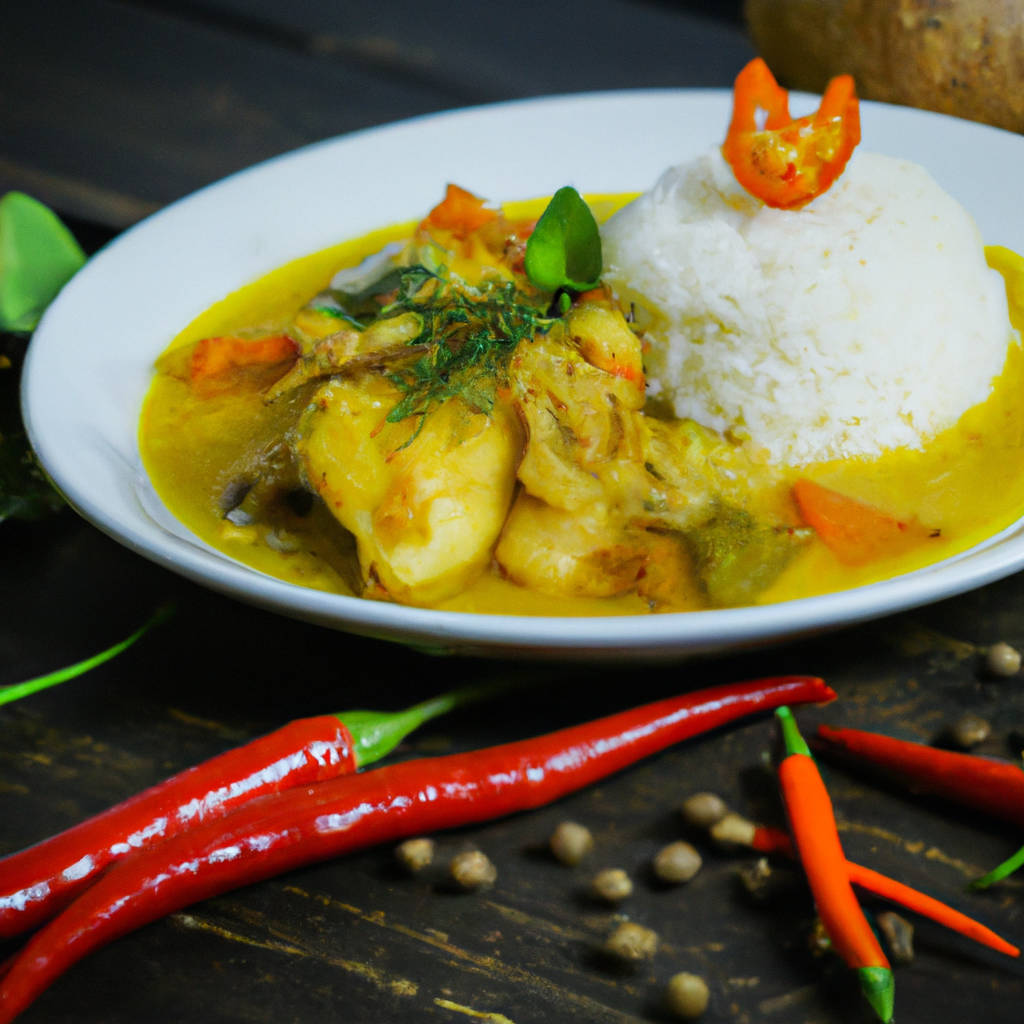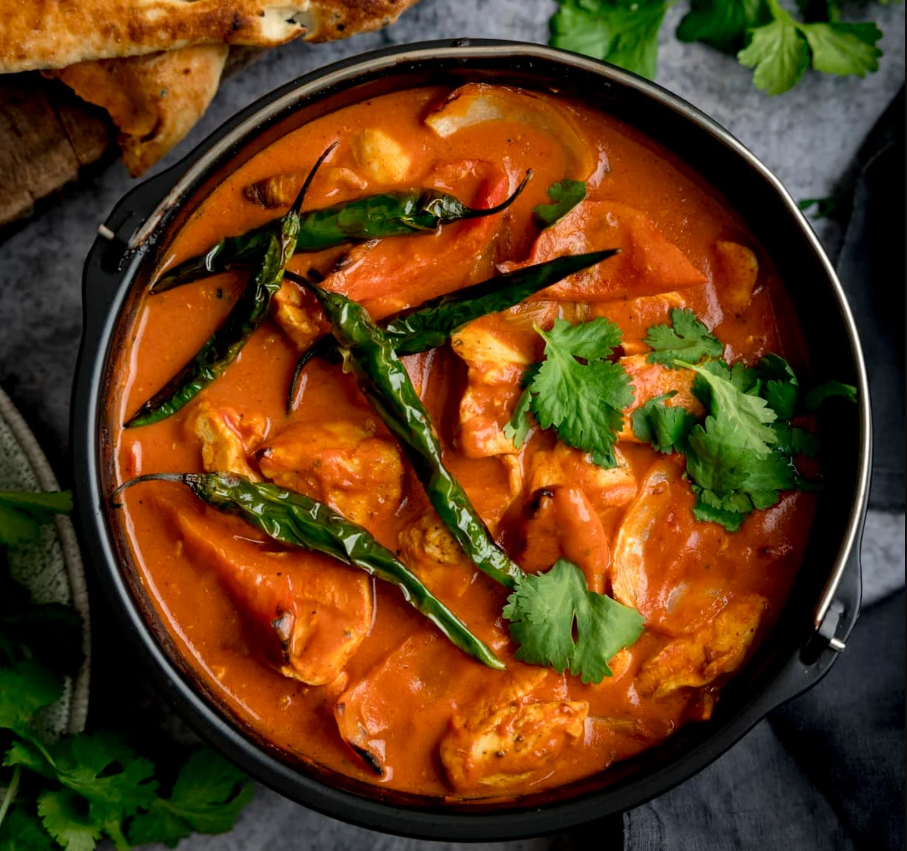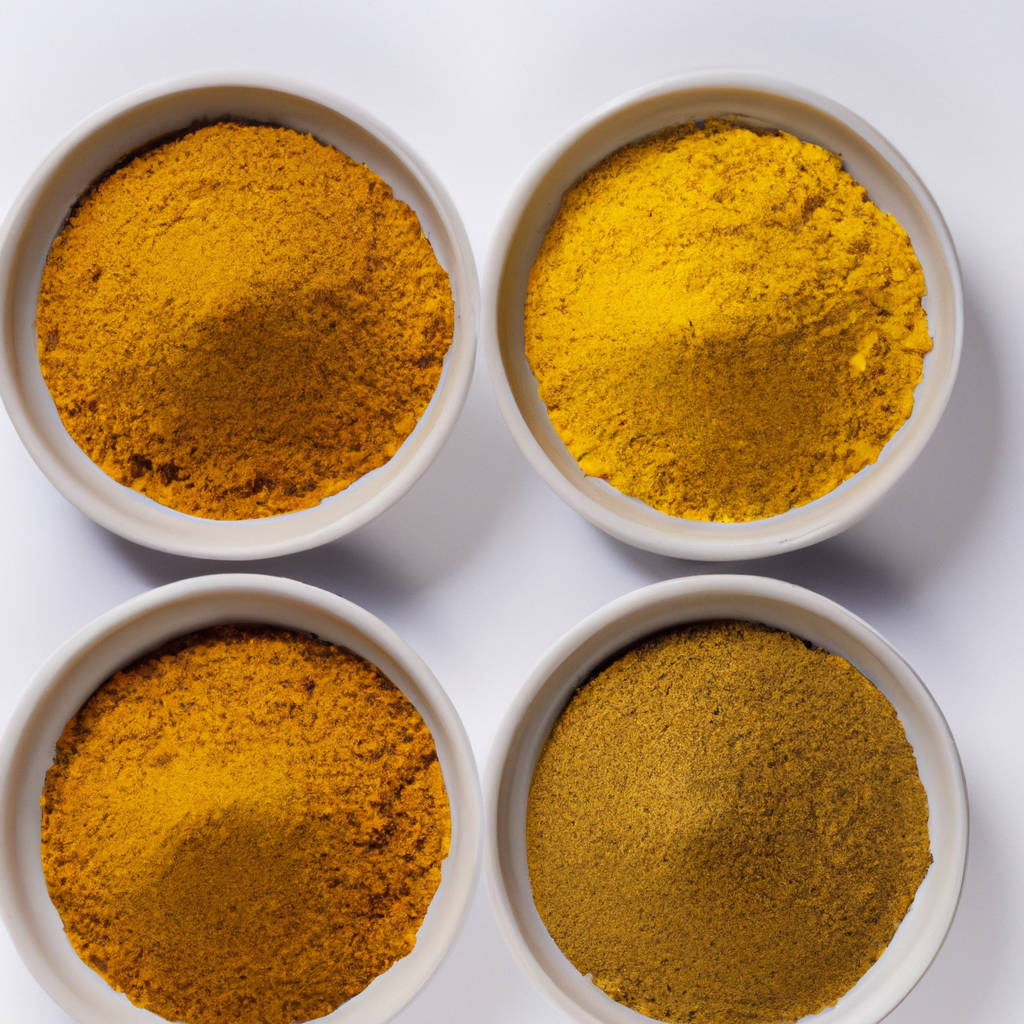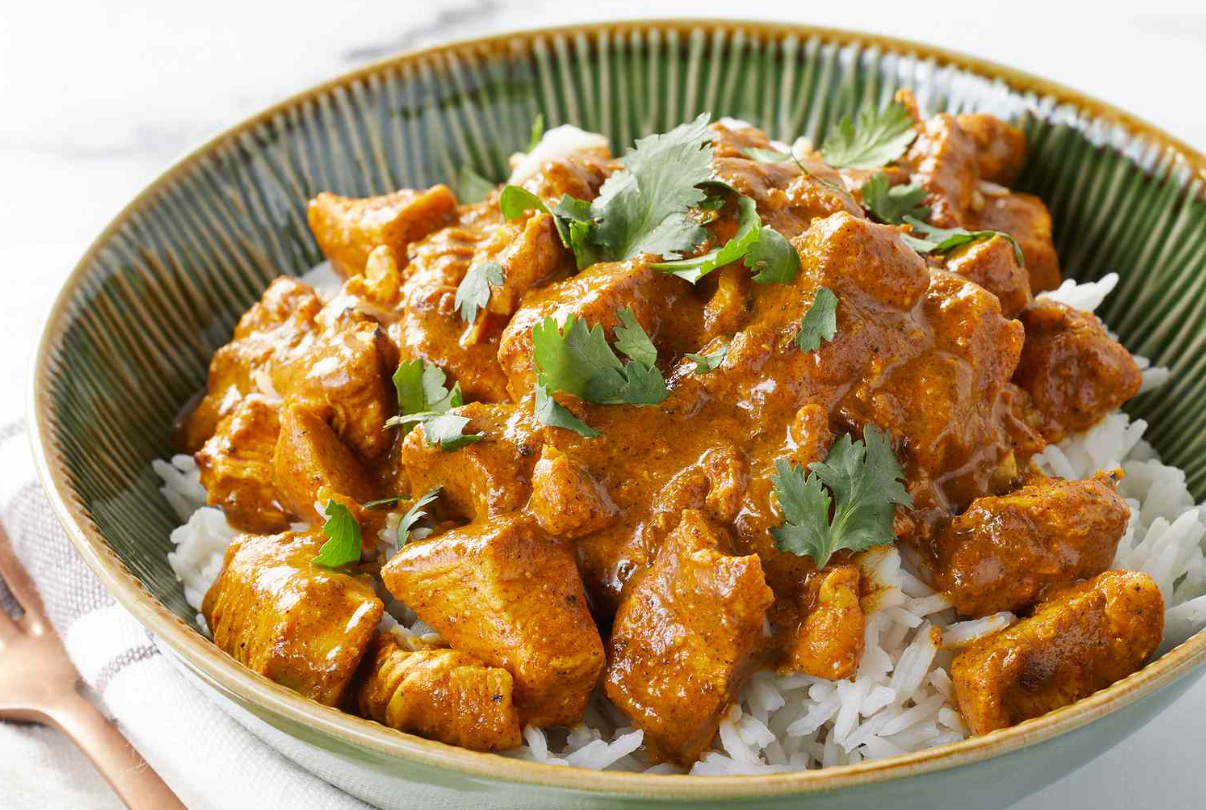Curry is a popular dish that has its origins in Asian cuisine and has become a staple in many households around the world. It is a flavorful and aromatic dish that typically consists of a combination of spices, herbs, and other ingredients such as meat, vegetables, or legumes. The dish is known for its vibrant colors and bold flavors, which come from a blend of spices such as turmeric, cumin, coriander, and chili powder. Curry can vary in spiciness, ranging from mild to extremely hot, depending on the region and personal preferences. In Asian cuisine, curry is commonly served with rice or bread, such as naan or roti, to soak up the delicious sauce.
There are many different types of curry found in Asian cuisine, with each region putting its own unique twist on the dish. For example, Indian curry is known for its rich and creamy sauces, often made with yogurt, cream, or coconut milk. Thai curry, on the other hand, is lighter and more fragrant, with a base of coconut milk and fresh herbs like lemongrass, galangal, and kaffir lime leaves. Japanese curry, influenced by British colonialism, is thicker and sweeter, often served with breaded and fried meat cutlets. Each type of curry has its own distinct flavor profile and ingredients, making it a versatile and customizable dish for cooks and food enthusiasts.
In addition to its rich and complex flavors, curry is also known for its health benefits. Many of the spices used in curry, such as turmeric and cumin, are believed to have anti-inflammatory and antioxidant properties. These spices have been used in traditional medicine for centuries to treat a variety of ailments, from digestive issues to joint pain. Additionally, the combination of protein, vegetables, and spices in curry makes it a nutritious and balanced meal option. By incorporating a variety of ingredients, curry can be a great way to get your daily dose of vitamins, minerals, and antioxidants.
One of the best things about curry is its versatility. It can be made with a wide range of ingredients, making it easy to customize to suit your taste preferences and dietary restrictions. Vegetarians and vegans can enjoy curry by using plant-based proteins like tofu, tempeh, or chickpeas as a substitute for meat. Those with gluten sensitivities can opt for rice or gluten-free bread as an accompaniment. Additionally, curry can be made with a variety of vegetables, making it a great way to use up any produce you have on hand. Whether you prefer a mild and creamy curry or a fiery and spicy one, there is a curry recipe out there for everyone to enjoy.
Overall, curry is a delicious and versatile dish that has become a beloved part of Asian cuisine. With its bold flavors, health benefits, and endless customization options, curry is a dish that can be enjoyed by people of all ages and backgrounds. Whether you’re a curry aficionado or new to the world of spicy Asian dishes, there is a curry recipe out there waiting for you to try. So grab your spices, vegetables, and protein of choice, and get ready to embark on a culinary adventure with curry.

Spicy Asian or Asian-Influenced Dishes – Description and Varieties of Curry
Spicy Asian or Asian-influenced dishes are known for their bold and complex flavors, with curry being a staple in many cuisines across the continent. Curry is a versatile dish that can be found in various forms, from the rich and creamy Indian curries to the fiery and aromatic Thai curries. Each variety of curry is unique in its ingredients and preparation methods, resulting in a wide range of flavors and heat levels. In Indian cuisine, curry often includes a blend of spices such as turmeric, cumin, coriander, and garam masala, along with ingredients like tomatoes, onions, and yogurt or coconut milk for added creaminess. Thai curries, on the other hand, are made with a base of coconut milk and flavored with ingredients like lemongrass, galangal, kaffir lime leaves, and Thai chilies. These curries are known for their intense heat and fragrant aromas, making them a favorite among spice lovers. Other Asian countries like Japan, Malaysia, and Indonesia also have their own versions of curry, each with its own unique twist on the dish. Whether you prefer a mild and comforting Japanese curry or a fiery and flavorful Thai curry, there is a variety of curry to suit every taste preference. With its rich history and diverse flavors, curry continues to be a beloved and iconic dish in Asian cuisine.
Etymology – Origin and Meaning of the Term “Curry”
The term “curry” has a complex and fascinating etymology that traces back to the Tamil word “kari” which means “sauce” or “relish for rice.” The term was later adopted by British colonialists in India during the 18th century to describe a variety of spiced dishes commonly found in South Asian cuisine. Over time, the term “curry” evolved to encompass a wide range of dishes that are prepared with a blend of aromatic spices, herbs, and other ingredients. It is important to note that the concept of “curry” is not limited to a specific recipe or cooking method, but rather represents a diverse and dynamic culinary tradition that varies greatly across different regions and cultures. In fact, the term “curry” has become so versatile that it is now used to describe a wide range of dishes from various cuisines around the world, including Thai, Japanese, and Caribbean.
Despite its widespread popularity, the term “curry” continues to be a subject of debate among food historians and linguists, with some arguing that it is a simplification of the rich and complex culinary traditions of South Asia, while others see it as a valuable cultural bridge that connects people from different backgrounds through a shared love of flavorful and aromatic dishes. Ultimately, the etymology of the term “curry” serves as a reminder of the diverse and interconnected nature of global cuisine, and the ways in which language and culture intertwine to shape our understanding of food and culinary traditions.

History – Historical Development and Evolution of Curry
Curry is a popular dish that has a long and rich history dating back centuries. The development and evolution of curry can be traced back to ancient civilizations such as the Indus Valley civilization and ancient Mesopotamia. These early civilizations used a variety of spices and herbs to flavor their food, which laid the foundation for the creation of curry as we know it today. The spread of trade routes and the exchange of goods between different cultures led to the incorporation of new ingredients and flavors into curry dishes, resulting in a diverse range of regional variations around the world.
In India, curry is a staple dish that varies greatly from region to region, with each area having its own unique blend of spices and cooking techniques. The use of spices such as turmeric, cumin, coriander, and chili peppers gives Indian curry its distinct flavor profile and vibrant color. In Thailand, curry is often made with coconut milk and fragrant herbs such as lemongrass and kaffir lime leaves, creating a creamy and aromatic dish that is beloved by many.
The British colonization of India in the 18th and 19th centuries played a significant role in popularizing curry in the Western world. British soldiers stationed in India developed a taste for the spicy dish and brought it back to England, where it quickly became a popular comfort food. Today, curry is enjoyed by people all over the world, with each culture putting its own unique spin on the dish.
The evolution of curry continues to this day, with chefs experimenting with new ingredients and techniques to create innovative and exciting dishes. Whether it’s a traditional Indian curry, a Thai curry, or a fusion dish that blends flavors from different cultures, curry remains a beloved and versatile dish that has stood the test of time.
By Region – Variations and Influences of Curry in Different Parts of the World
Curry is a popular dish that varies widely in taste, ingredients, and preparation methods depending on the region in which it is made. In India, curry is a staple dish that can be found in many different forms, from the spicy and rich flavors of a traditional North Indian curry to the lighter and milder flavors of a South Indian curry. The use of different spices and ingredients, such as garam masala, turmeric, and coconut milk, all play a role in creating the distinct flavors of each region’s curry. In Thailand, curry is often made with a base of coconut milk and flavored with ingredients like lemongrass, galangal, and kaffir lime leaves, giving it a unique and fragrant taste. In Japan, curry is a popular dish that has been adapted to suit Japanese tastes, often incorporating ingredients like soy sauce, mirin, and dashi broth to create a milder and slightly sweet curry.
In the Caribbean, curry has been influenced by the flavors of the region, incorporating ingredients like scotch bonnet peppers, allspice, and thyme to create a spicy and aromatic dish. Overall, the variations and influences of curry in different parts of the world showcase the diversity and adaptability of this beloved dish, making it a truly global culinary phenomenon.

Southeast Asia – Curry Varieties and Traditions in Southeast Asian Cuisine
Southeast Asia is a region known for its diverse and flavorful curry varieties that play a central role in the local cuisine. From Thailand to Indonesia, each country has its own unique take on this beloved dish, incorporating a blend of aromatic spices, herbs, and ingredients that create a symphony of flavors. In Thailand, green curry is a popular choice, made with a paste of green chilies, lemongrass, galangal, and kaffir lime leaves. This curry is known for its vibrant color and spicy kick. In Malaysia, rendang curry is a slow-cooked dish that features tender chunks of meat simmered in a rich, coconut-based sauce with a medley of spices like cinnamon, cloves, and star anise. In Indonesia, sambal is a fiery chili paste that is often used as a base for curries, adding a bold and spicy flavor to dishes.
One of the most fascinating aspects of Southeast Asian curry traditions is the influence of different cultures and histories on the development of these dishes. For example, Indian traders brought curry spices to the region centuries ago, leading to the incorporation of ingredients like turmeric, cumin, and coriander into local recipes. Chinese immigrants also played a role in shaping Southeast Asian curries, introducing cooking techniques and ingredients like soy sauce and tofu. As a result, the curries of Southeast Asia have evolved to reflect a rich tapestry of culinary influences, creating a truly unique and diverse cuisine.
In addition to the wide array of curry varieties, Southeast Asian countries also have their own set of traditions and customs when it comes to preparing and enjoying these dishes. In Thailand, for example, curry pastes are often made from scratch using a mortar and pestle to ensure the flavors are well blended. In Malaysia, curry is often served with a side of rice or bread, allowing diners to soak up the flavorful sauce. In Indonesia, curries are often enjoyed as part of a communal meal, with large platters of food shared among family and friends. These traditions not only enhance the dining experience but also serve as a way to bring people together and celebrate the rich culinary heritage of the region.
Africa – Influence and Adaptation of Curry in African Culinary Traditions
Curry has become a prominent ingredient in African culinary traditions, with its origins tracing back to the Indian subcontinent. Over time, curry has been adapted and incorporated into various African dishes, creating a unique fusion of flavors that reflect the diverse cultural influences on the continent. The influence of curry in African cuisine can be seen in dishes like bobotie in South Africa, which is a savory pie made with minced meat, fruit, and curry powder. In West Africa, dishes like jollof rice and peanut soup often feature curry as a key seasoning, adding depth and complexity to the flavors. The adaptation of curry in African culinary traditions showcases the region’s ability to incorporate foreign ingredients and techniques while still maintaining its own distinct identity.
One of the reasons for the popularity of curry in African cuisine is its versatility and ability to enhance the flavors of various ingredients. The aromatic blend of spices in curry powder, such as turmeric, cumin, coriander, and fenugreek, can transform even the simplest of dishes into a culinary delight. In addition, curry’s bold and robust flavors pair well with the rich and hearty ingredients commonly found in African cooking, such as meats, root vegetables, and legumes. This compatibility has led to the widespread use of curry in African dishes, making it a staple in many households across the continent.
Furthermore, the adaptation of curry in African culinary traditions highlights the interconnectedness of global food cultures. As trade routes expanded and civilizations interacted, ingredients and culinary techniques were exchanged and integrated into local cuisines. The incorporation of curry into African dishes is a testament to this cultural exchange and the ability of food to transcend borders and boundaries. Ultimately, the influence and adaptation of curry in African culinary traditions serve as a reminder of the richness and diversity of the continent’s food heritage.

Europe – European Adaptations and Usage of Curry
Curry has a long history in Europe, with its roots dating back to the colonial era when British traders brought the spice blend back from India. Over the years, Europeans have adapted and incorporated curry into their cuisines, creating unique and flavorful dishes that reflect the diverse cultures and influences of the continent. In countries like the UK, curry has become a staple dish, with curry houses popping up in every corner and curry being considered a national dish. European chefs have also put their own twist on traditional curry recipes, using local ingredients and techniques to create new and innovative dishes.
The popularity of curry in Europe has led to the creation of a wide variety of curry powders, pastes, and sauces that cater to different tastes and preferences. From mild and creamy kormas to fiery vindaloos, there is a curry dish for everyone in Europe. Additionally, curry has also made its way into other aspects of European culture, such as fashion, music, and art. The vibrant colors and bold flavors of curry have inspired designers, musicians, and artists, leading to a fusion of Indian and European styles and trends. Overall, the adaptation and usage of curry in Europe have helped to create a rich tapestry of flavors and experiences that celebrate the diversity and creativity of the continent.
Curry Powder – Composition and Usage of Curry Powder in Culinary Practices
Curry powder is a versatile spice blend that is commonly used in a variety of culinary dishes around the world. It is typically made up of a combination of various spices such as coriander, turmeric, cumin, fenugreek, and chili peppers. The exact composition of curry powder can vary depending on the region or individual preferences, but the combination of these spices gives it a unique and complex flavor profile that is both savory and aromatic. In culinary practices, curry powder is often used to add depth and richness to dishes such as curries, stews, soups, and marinades. It can be used as a dry rub for meats or vegetables before grilling or roasting, or added to sauces and gravies to enhance the overall flavor. Additionally, curry powder can be used as a seasoning for rice dishes, salads, and even baked goods. Its versatility and bold flavors make it a staple in many kitchens and a popular choice for those looking to add a bit of spice and warmth to their dishes. Whether used in traditional Indian cuisine or in fusion dishes, curry powder is a key ingredient that can elevate the overall taste and experience of a meal.